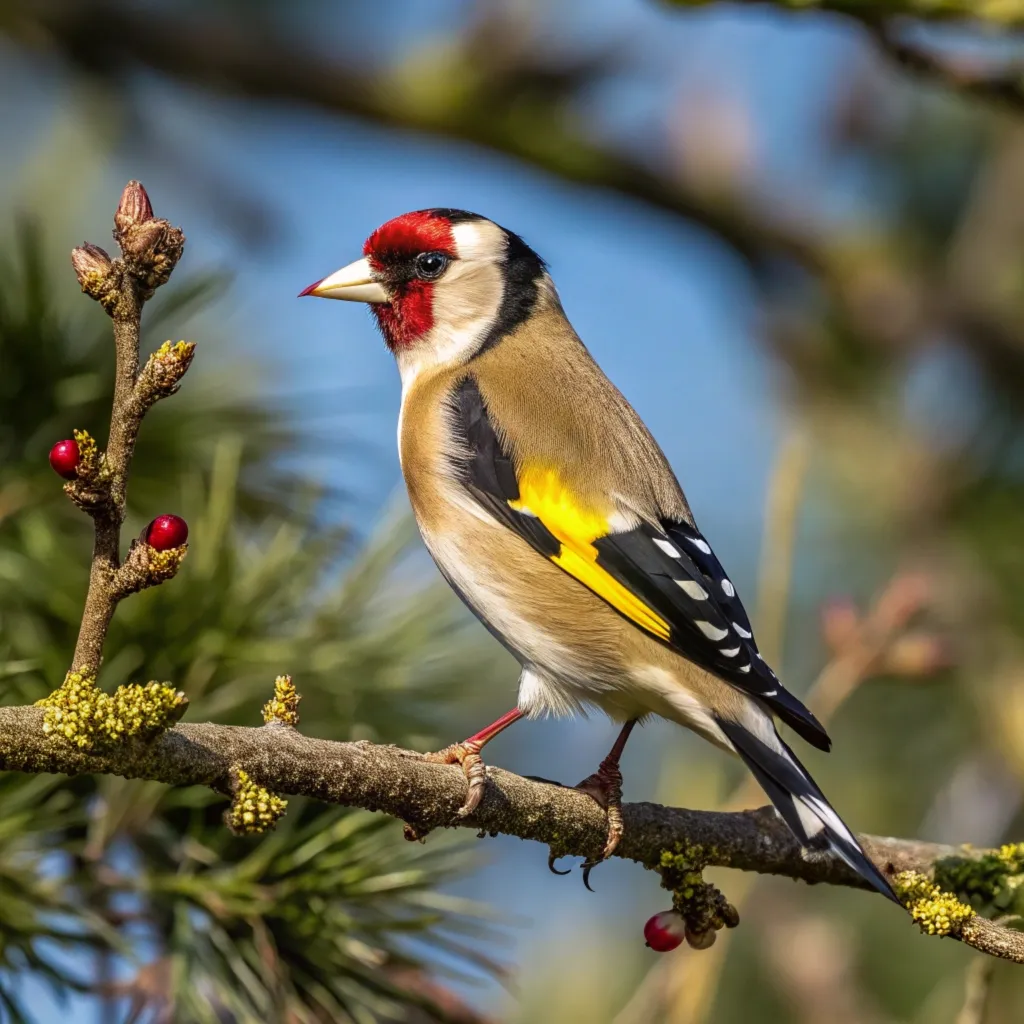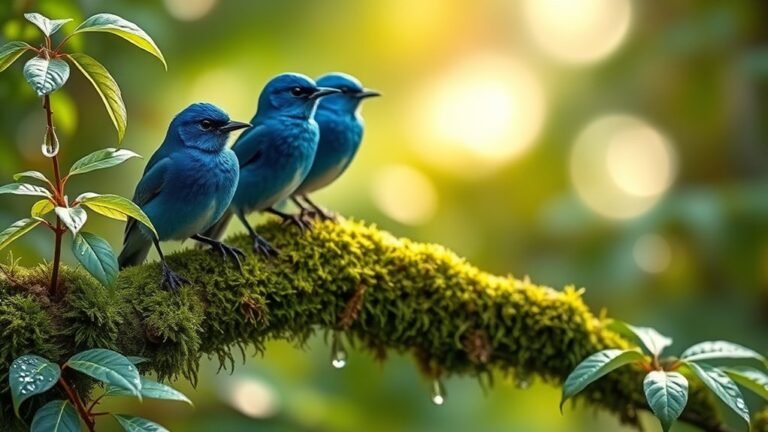European Goldfinch: A Comprehensive Guide
The European Goldfinch, a captivating and colorful bird species, has long fascinated bird enthusiasts and nature lovers alike.
This detailed exploration delves into the distinctive characteristics and intriguing habits of these charming creatures, offering a comprehensive look at their world.
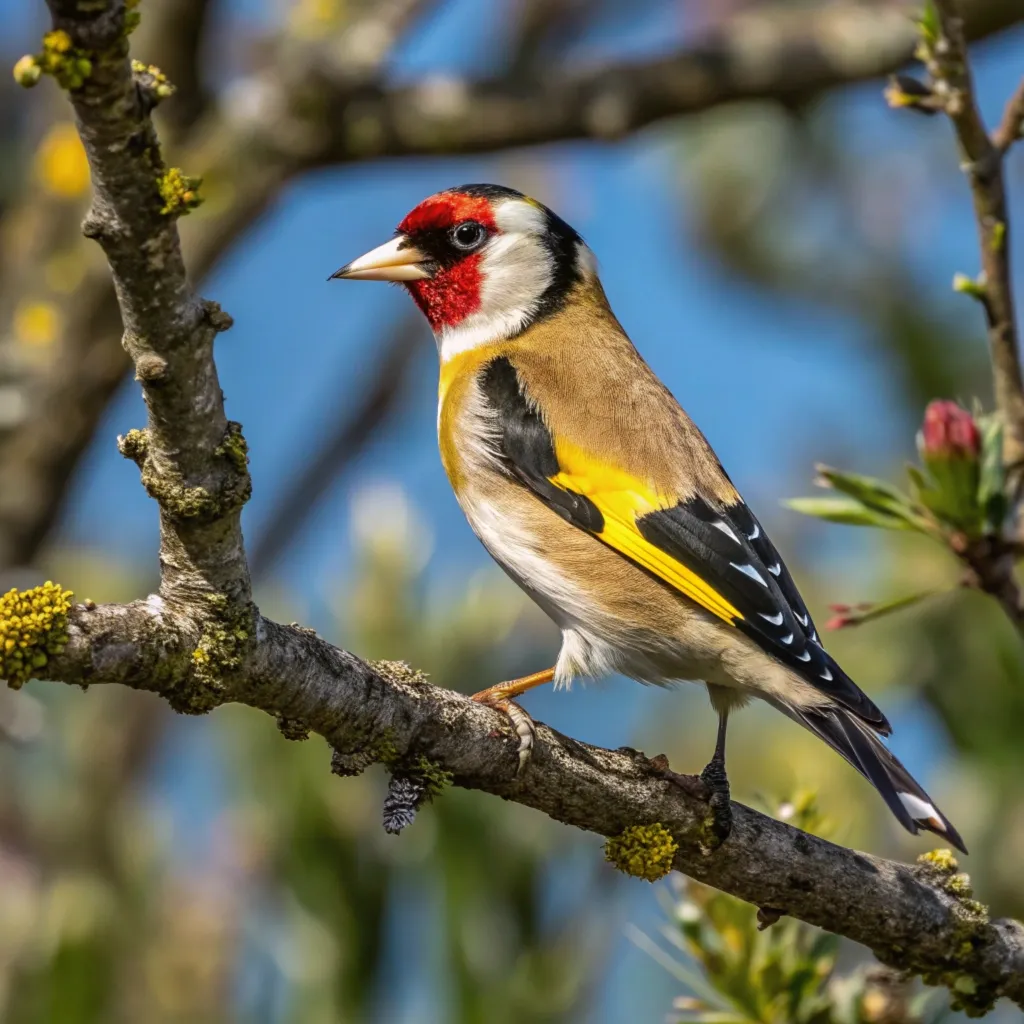
Key Takeaways: European Goldfinch at a Glance
- Vibrant Appearance: European Goldfinches boast a striking color palette with red, white, and black facial markings, and yellow-patched wings.
- Habitat Versatility: These birds thrive in diverse environments, from woodlands and orchards to urban parks and gardens.
- Social Nature: Goldfinches are highly social, often forming large flocks, especially during winter months.
- Seed Specialists: Their diet primarily consists of small seeds, with a particular fondness for thistle seeds.
- Melodious Vocalization: Known for their pleasant, tinkling songs and distinctive calls.
- Breeding Behavior: They exhibit interesting courtship displays and nest-building techniques.
- Migratory Patterns: Some populations are resident, while others migrate to warmer regions in winter.
- Conservation Concerns: Illegal trapping and habitat loss pose significant threats to their populations.
- Adaptability: European Goldfinches have successfully adapted to human-altered landscapes, often visiting backyard feeders.
- Lifespan: On average, they live for about 2.4 years in the wild.
Physical Characteristics of the European Goldfinch
The European Goldfinch stands out with its vibrant plumage and distinctive markings. These small birds measure between 4.7 to 5.1 inches in length, with a wingspan ranging from 8.3 to 9.8 inches.
Their most striking feature is the bright red face mask, which contrasts beautifully with the white and black stripes on their head.
The wings of the European Goldfinch are a marvel of nature, displaying a stunning combination of black feathers with bright yellow patches. This color pattern not only enhances their beauty but also plays a crucial role in their courtship displays.
The body structure of the European Goldfinch is perfectly adapted for its lifestyle. Their slender build and pointed beak allow for agile movement among branches and efficient seed extraction.
The tail feathers are slightly forked, providing excellent maneuverability during flight. This combination of features makes the European Goldfinch a true aerial acrobat, capable of swift, precise movements when foraging or evading predators.
Their eyes, though small, are remarkably keen, enabling them to spot tiny seeds and potential threats from a distance. This visual acuity is crucial for their survival in varied habitats.
Habitat and Distribution
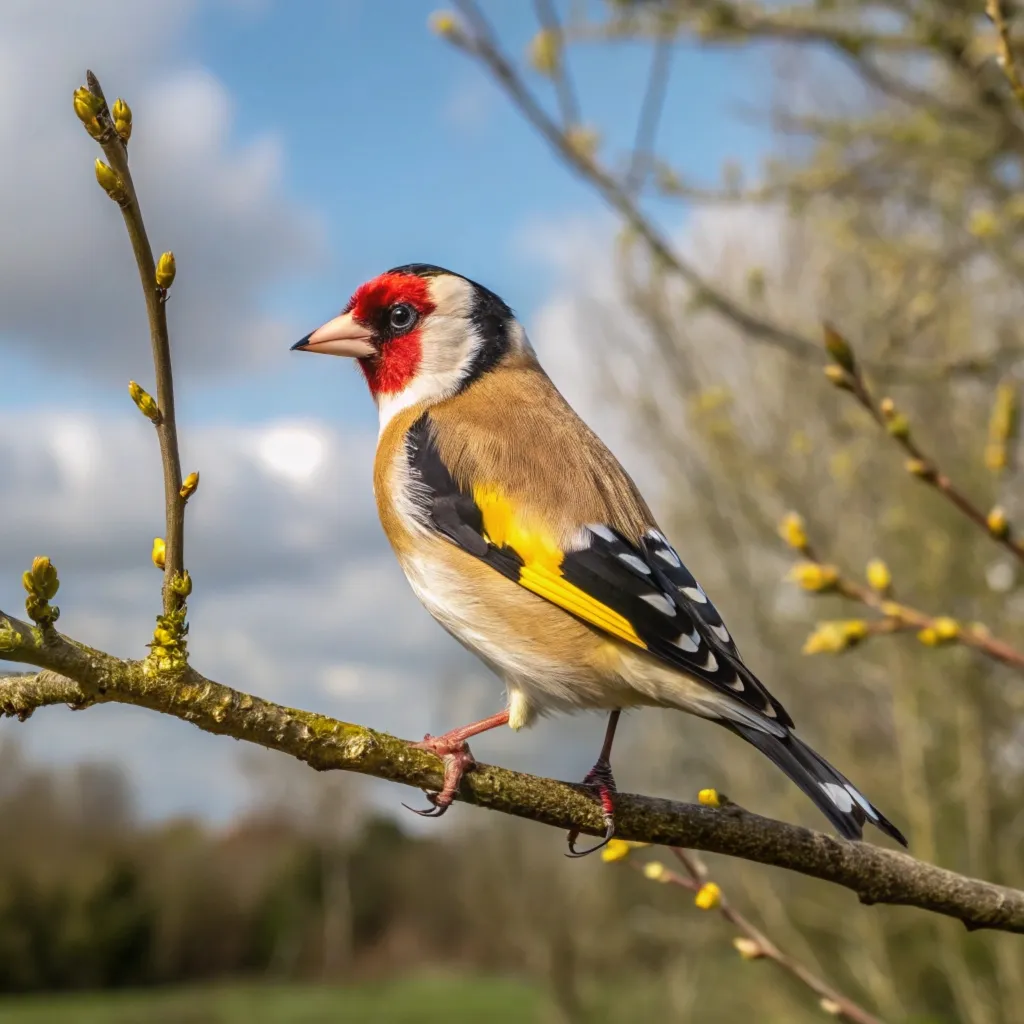
European Goldfinches demonstrate remarkable adaptability in their choice of habitats. They thrive in a variety of environments, including:
- Woodlands
- Orchards
- Parks and gardens
- Thickets
- Areas close to human habitation
Their geographic range is extensive, covering much of Europe, parts of North Africa, and extending into Western and Central Asia.
In recent years, due to both intentional introductions and escapes from captivity, European Goldfinches have also established populations in other parts of the world.
The versatility of European Goldfinches in habitat selection has contributed significantly to their widespread distribution.
These birds are equally at home in rural landscapes and urban settings, adapting well to human-altered environments. Their ability to thrive in diverse ecosystems showcases their ecological flexibility and resilience.
In urban areas, European Goldfinches often frequent city parks and residential gardens, particularly those with a variety of seed-bearing plants.
This adaptability has allowed them to maintain stable populations even as natural habitats diminish.
Social Behavior and Communication
One of the most fascinating aspects of European Goldfinches is their highly social nature. During the winter months, these birds form large flocks, often consisting of 40 to 100 individuals.
This social behavior not only provides safety in numbers but also enhances their foraging efficiency.
Communication among European Goldfinches is primarily vocal. Their repertoire includes:
- A melodic “tickeLIT” call
- A pleasant song composed of trills and twitters
- Guttural “krrr krrr” sounds during feeding or disputes
These vocalizations play a crucial role in maintaining flock cohesion, signaling danger, and during courtship.
The social dynamics within European Goldfinch flocks are complex and fascinating. They exhibit a hierarchical structure, with dominant individuals often taking the lead in foraging and alerting the group to potential threats.
This social organization enhances the overall survival rate of the flock, as it allows for efficient resource allocation and improved vigilance against predators.
Interestingly, European Goldfinches also engage in a behavior known as allopreening, where individuals groom each other. This activity strengthens social bonds within the flock.
Feeding Habits and Diet
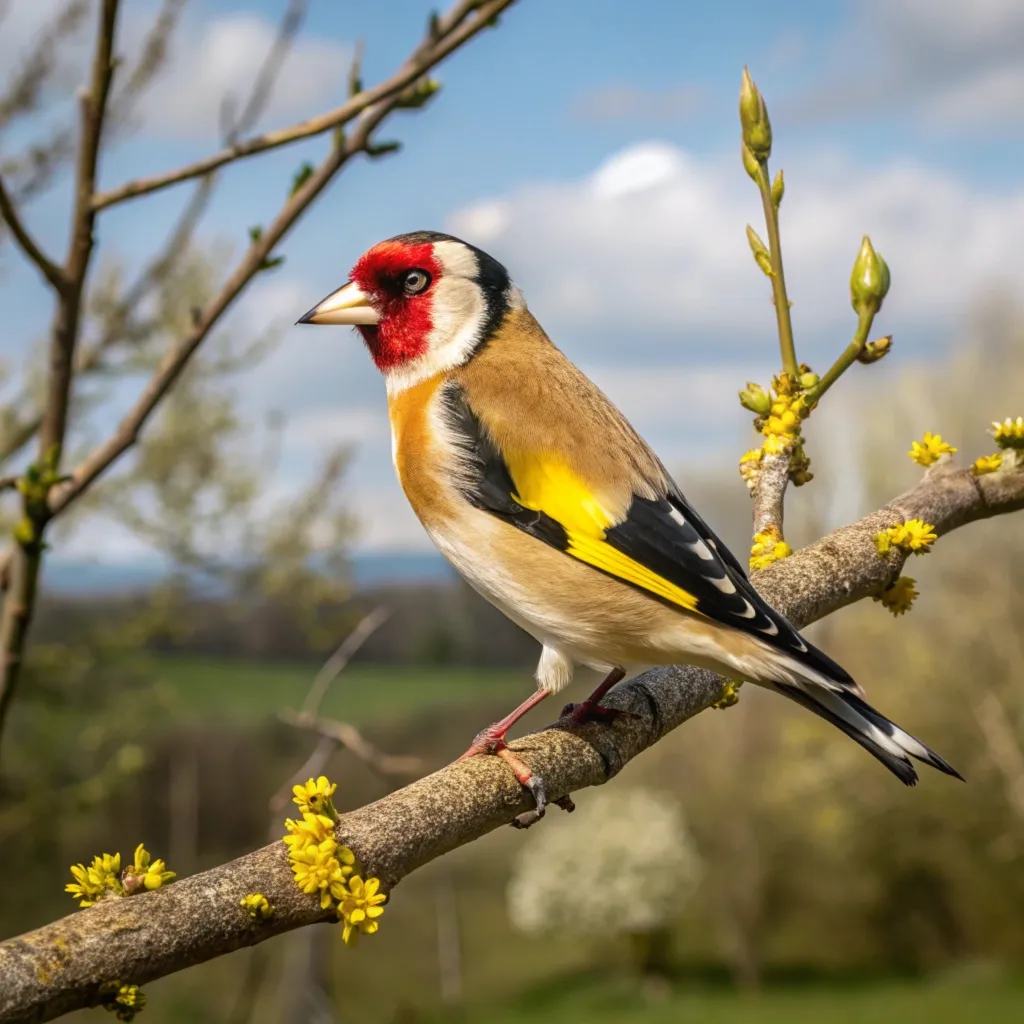
European Goldfinches are primarily herbivorous, with a strong preference for small seeds. Their diet includes:
- Seeds from thistles and teasels
- Buds and flowers
- Fruits of various plants
- Insects (mainly when feeding young)
Their feeding behavior is quite distinctive. These agile birds are often seen hovering from plant to plant, sometimes even feeding upside down to reach their preferred food sources. This adaptability in feeding techniques allows them to exploit a wide range of food resources.
The specialized beak of the European Goldfinch plays a crucial role in its feeding habits. The long, pointed beak is perfectly adapted for extracting seeds from various plants, especially thistles.
This adaptation allows them to access food sources that many other bird species cannot, giving them a competitive edge in diverse habitats.
During the breeding season, European Goldfinches slightly alter their diet to include more protein-rich foods like small insects and spiders. This dietary shift is crucial for providing adequate nutrition to their growing chicks.
Breeding and Nesting Behavior
The breeding season for European Goldfinches typically begins in March, marked by elaborate courtship displays. The male’s display involves:
- Perching close to the female
- Stretching wings alternately
- Swaying from side to side to showcase yellow wing patches
Nest construction is solely the female’s responsibility. She builds a neat and compact nest, usually several meters above the ground, hidden among leaves at the end of a branch. The nest is constructed using:
- Mosses and lichens
- Plant down (especially from thistles)
- Spider silk (for attaching the nest to twigs)
The female typically lays a clutch of 4-6 whitish eggs with reddish-brown speckles. Incubation lasts for 11-13 days, and the young fledge after 13-18 days.
The parental care exhibited by European Goldfinches is highly dedicated. Both parents participate in feeding the chicks, making numerous trips to the nest with regurgitated seeds and small insects.
This intensive care ensures rapid growth and development of the young, preparing them for the challenges of life outside the nest.
Interestingly, European Goldfinches often raise multiple broods in a single breeding season, typically two or three. This reproductive strategy helps maintain stable population levels.
Migration Patterns
European Goldfinches exhibit varied migratory behaviors depending on their location:
- Populations in temperate regions often stay year-round
- Birds in colder areas migrate to warmer regions during winter
- Some UK populations remain throughout the year, while others may migrate as far south as Spain
This flexibility in migration patterns demonstrates their adaptability to different climatic conditions.
The migratory journey of European Goldfinches is a remarkable feat of endurance and navigation. Birds that do migrate can travel hundreds of miles, often flying in large flocks.
These journeys are typically undertaken at night, with the birds using a combination of celestial and magnetic cues to navigate.
Climate change is increasingly affecting the migration patterns of European Goldfinches. Warmer winters in northern regions are leading to more birds overwintering in their breeding grounds, potentially altering long-established migratory routes and timings.
Conservation Status and Threats
While European Goldfinches are not currently considered endangered, they face several threats:
- Illegal trapping and hunting
- Habitat loss due to urbanization and agricultural intensification
- Climate change impacts on their breeding and feeding habitats
Conservation efforts focus on protecting their habitats and enforcing laws against illegal trapping and trade.
The conservation challenges facing European Goldfinches are multifaceted and complex. Habitat fragmentation due to urban expansion and intensive agriculture has led to a reduction in suitable breeding and foraging areas.
This loss of habitat not only affects the goldfinches directly but also impacts the availability of their preferred food sources, particularly thistle plants.
Efforts to protect European Goldfinches include stricter enforcement of anti-poaching laws, habitat restoration projects, and public education campaigns to raise awareness about the importance of these birds in ecosystems.
Interaction with Humans
European Goldfinches have a long history of interaction with humans. They are:
- Popular visitors to backyard bird feeders
- Often kept as caged birds (though this practice is controversial and often illegal)
- Subjects of artistic and cultural significance in many European countries
The relationship between European Goldfinches and humans is complex and multifaceted. These birds have been celebrated in art and literature for centuries, often symbolizing beauty, freedom, and resilience.
Their vibrant plumage and melodious songs have made them popular subjects in paintings, poetry, and folklore across Europe.
In recent years, there has been a growing trend of wildlife-friendly gardening, with many people specifically planting native flowers and installing specialized feeders to attract European Goldfinches to their yards.
This trend not only benefits the birds but also fosters a greater connection between humans and nature in urban environments.
Unique Adaptations
These birds have developed several adaptations that contribute to their success:
- Strong, pointed beaks ideal for extracting seeds
- Agile flight patterns for efficient foraging
- Social behaviors that enhance survival rates
The evolutionary journey of European Goldfinches has equipped them with remarkable adaptations. Their specialized beak structure is a prime example of natural selection at work.
The long, pointed beak allows them to extract seeds from thistles and other plants with precision, giving them access to food sources that many other birds cannot exploit.
Their agile flight capabilities are another key adaptation. European Goldfinches can perform intricate aerial maneuvers, enabling them to feed on seeds while hanging upside down or in other precarious positions. This skill not only aids in foraging but also helps in evading predators.
Role in Ecosystem
European Goldfinches play a significant role in their ecosystems:
- Seed dispersal through their feeding habits
- Control of weed populations by consuming their seeds
- Serving as prey for various predators, including birds of prey
The ecological importance of European Goldfinches extends far beyond their charming appearance. As seed consumers, they play a crucial role in plant population dynamics.
By feeding on and dispersing seeds, they contribute to the spread and regeneration of various plant species, including some that are considered weeds by humans.
Their presence in an ecosystem also supports higher trophic levels. European Goldfinches serve as prey for several predator species, including sparrowhawks and other raptors, thus contributing to the overall biodiversity and balance of their habitats.
Interesting Facts about European Goldfinches
- Their scientific name, Carduelis carduelis, is derived from the Latin word for thistle
- They have been featured in numerous paintings and poems throughout European history
- Their popularity as caged birds has led to their introduction in various parts of the world
The cultural significance of European Goldfinches is deeply rooted in European history. These birds have been symbols of resilience and freedom in various cultures.
Their ability to thrive in diverse environments, including urban areas, has made them a familiar and beloved species across much of their range.
Interestingly, the European Goldfinch’s association with thistles is so strong that in some languages, their name directly translates to “thistle bird” or “thistle finch”. This connection highlights the intricate relationship between these birds and their preferred food source.
Future Prospects and Research
Ongoing research on European Goldfinches focuses on:
- Understanding their adaptation to urban environments
- Studying the impacts of climate change on their populations
- Developing more effective conservation strategies
The future of European Goldfinch research holds exciting possibilities. Scientists are increasingly using advanced technologies such as GPS tracking and genetic analysis to gain deeper insights into the migration patterns, population dynamics, and evolutionary history of these birds.
These studies are crucial for developing targeted conservation strategies and understanding how European Goldfinches might adapt to future environmental changes.
Researchers are also exploring the potential of European Goldfinches as bioindicators of environmental health, given their sensitivity to habitat changes and their widespread distribution across various ecosystems.
FAQs about European Goldfinches
How long do European Goldfinches live?
European Goldfinches typically live for about 2.4 years on average in the wild, though some individuals may live longer under favorable conditions.
What do European Goldfinches eat?
European Goldfinches primarily feed on small seeds, especially those from thistles and teasels. They also consume buds, flowers, and fruits of various plants. During breeding season, they may include small insects in their diet, particularly when feeding their young.
Are European Goldfinches migratory?
Some European Goldfinch populations are migratory, while others are resident. Birds in colder regions often migrate south during winter, while those in temperate areas may stay year-round. The extent of migration can vary depending on local climate conditions.
How can I attract European Goldfinches to my garden?
To attract European Goldfinches, provide bird feeders with niger seeds or thistle seeds. Planting native flowers and allowing some weeds to grow in your garden can also create a natural food source for these birds.
Are European Goldfinches endangered?
European Goldfinches are not currently considered endangered. However, they face threats from illegal trapping, habitat loss, and climate change. Conservation efforts are ongoing to protect their populations and habitats.

Joyce is the passionate founder of Chirping Hearts, a website dedicated to sharing her love for birds and providing valuable information about avian life. With a background in ornithology and years of experience in birdwatching, Joyce aims to inspire others to appreciate the beauty and diversity of birds. Through her engaging articles and guides, she hopes to foster a community of bird enthusiasts who share her enthusiasm for these incredible creatures. When she’s not writing, Joyce enjoys exploring nature trails and observing birds in their natural habitats.

